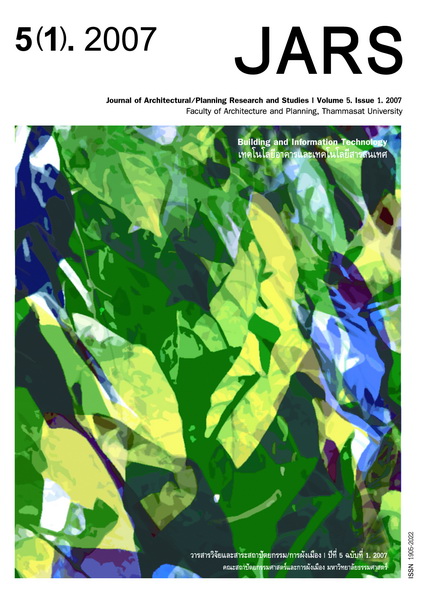The Performance of Climbing-Plant Panel for Reducing Heat Transfer through Solid Wall
Main Article Content
Abstract
This research paper presents guidelines for using climbing-plant panel for reducing heat
transmission through solid wall. In real environment, climbing-plant panels and test cells are conducted
in the experiments and the scientific tools are used to collect data. The results of the research found
that the climbing-plant panel has an excellent performance for reducing heat transfer. The more the
leaf covering area is, the less the heat transfers. The more the distance is, the more the heat transfers.
It can be concluded that 85 percent or more of leaf covering area, two or more layers of leaf, and 15 cm.
depth of bush are the appropriate physical characters of the climbing-plant that should be used. For
optimum efficiency, in terms of temperature and humidity, the distance between climbing-plant panel
and solid wall should be 15 cm. In conclusion, climbing-plant panel can reduce not only the heat transfer
through building envelope, but also the urban heat island and the greenhouse effect which are the
serious issues at the present.
Downloads
Article Details

This work is licensed under a Creative Commons Attribution-NonCommercial-NoDerivatives 4.0 International License.
All material is licensed under the terms of the Creative Commons Attribution 4.0 International (CC-BY-NC-ND 4.0) License, unless otherwise stated. As such, authors are free to share, copy, and redistribute the material in any medium or format. The authors must give appropriate credit, provide a link to the license, and indicate if changes were made. The authors may do so in any reasonable manner, but not in any way that suggests the licensor endorses you or your use. The authors may not use the material for commercial purposes. If the authors remix, transform, or build upon the material, they may not distribute the modified material, unless permission is obtained from JARS. Final, accepted versions of the paper may be posted on third party repositories, provided appropriate acknowledgement to the original source is clearly noted.
References
Stein, B., & Reynolds, J. (2001). Mechanical and electrical equipment for buildings. New York: John Wiley & Sons.
สุดสวาท ศรีสถาปัตย์. (2545). การออกแบบวัสดุพืชพันธุ์และการประหยัดพลังงาน. กรุงเทพฯ: โรงพิมพ์แห่งจุฬาลงกรณ์มหาวิทยาลัย.
Givoni, B. (1998). Climate consideration in building and urban design. New York: John Wiley & Sons.
Dunnett, N. (2004). Planting green roofs and living walls. Portland, OR: Timber Press.
The American Society of Heating Refrigerating and Air-condition Engineers. (2001). ASHRAE Handbook Fundamentals (SI): Air Contaminants. Atlanta, GA: ASHRAE.


